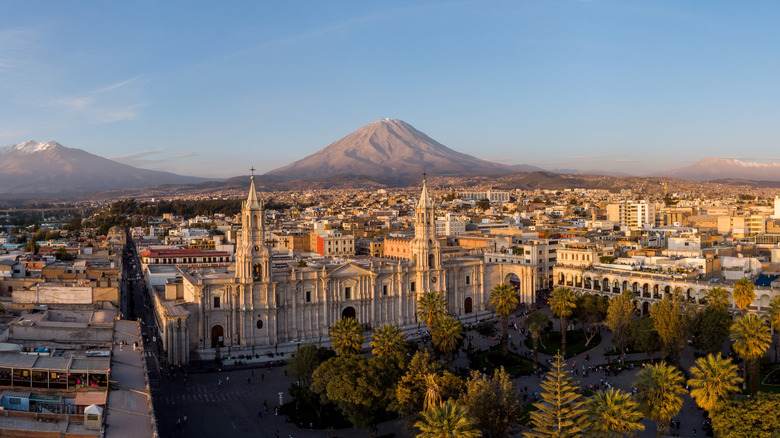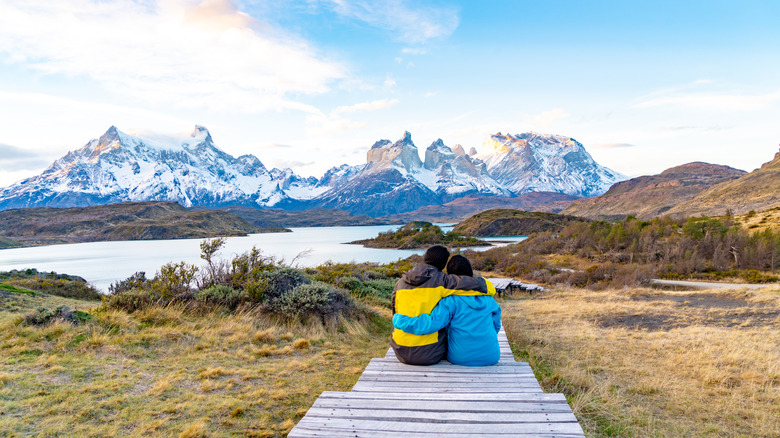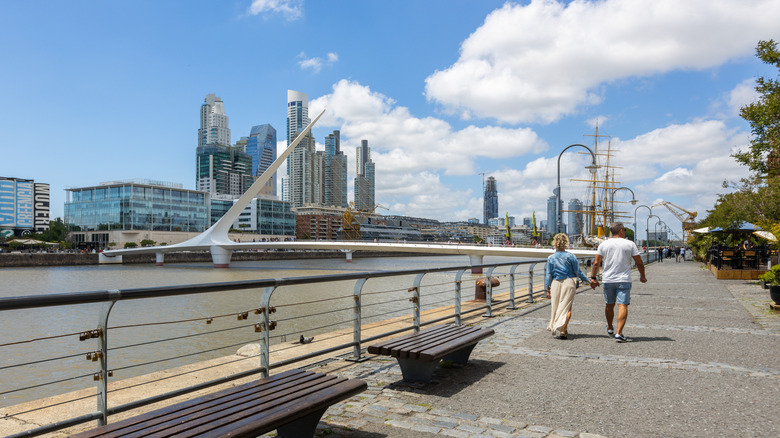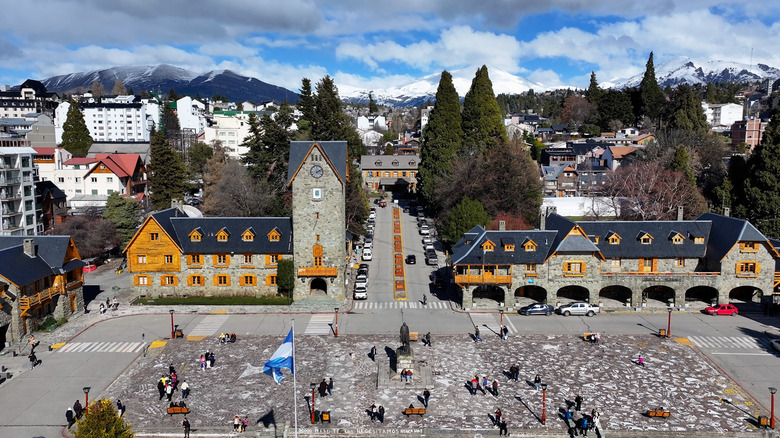The Best South American Countries To Retire In For Safety, Beauty, And Affordability, According To Research
So it's time for you to retire — lucky you! Now comes one of the fun parts: Deciding where you want to retire. If you're from North America and parts of Europe, the high cost of living can make retirement feel stressful or even impossible, even if you choose one of the best states to retire to in the U.S. While you could work as long as possible or retire somewhere less desirable, there's another way. Instead of putting off your retreat or settling in an unsavory area for the sake of lower costs, think about heading to one of these vibrant, exciting, and beautiful countries in South America.
Choosing where to retire is serious business, of course. We utilized the best sources for this article to ensure our list includes the safest, most affordable, and most beautiful countries (we'll touch more on our methodology later). While parts of the continent certainly aren't secure, most of South America gets a bad rap. There are plenty of cities and areas that provide all the beauty, activity, and quality of life any retiree could hope for and are as safe as much of North America. In fact, every country on this list ranks higher on the 2024 Global Peace Index (GPI) than the United States.
Uruguay
Anthony Bourdain once called Uruguay one of the world's most underrated countries. Not only does it offer a good value, but it's also beautiful — hello coastline! — with great weather, vibrant cities, endless wineries, and historical landmarks. In addition, Uruguay is one of the most politically and economically stable countries on the continent, as well as having the distinction as one of the safest countries in South America, second only to Argentina.
Uruguay also attracts retirees due to its "pensionado" visa (retirement or pensioner visa), which is easily obtained if you make $1,500 in retirement per month, buy a property worth at least $100,000, and pass a background check. In addition, the forests, wineries, white-sand beaches, and mild climate are a huge draw, as are the progressive culture, affordable yet quality healthcare (often considered one of the world's best healthcare systems), low taxes, and low cost/high standard of living. Many retirees settle in the capital, Montevideo, the beachside haven of Punta del Este, or the sleepy beach city of Piriapolis. It's a "country for old men," according to one Reddit user on r/uruguay. "The pace of the country is really relaxed," another chimed in. "If you are retired, this can be a good thing."
Bolivia
When talking about underrated countries in South America, Bolivia certainly comes up on the list. Overshadowed by neighbors Peru and Brazil with their famous natural wonders, Bolivia is home to its fair share of incredible landscapes, like the salt flats of Salar de Uyuni, the world's largest natural mirror, a surreal landscape of water, salt and sky. With its score on the GPI and affordability, not to mention the friendly locals, it's an ideal place for retirees.
Bolivia does not have a specific retirement visa, but you can apply for an extended stay during your tourist visa (30 days for Americans). The request is made under a "specific purpose visa" — in your case, retirement — at the Administración Nacional de Migración (National Migration Service). To qualify, you'll need to prove income of at least $300 per month, pass a background check, and pay a fee of approximately $350 USD. Although to get the visa, you only need $300 monthly, current Bolivian residents recommend at least $1500 a month for a comfortable life. The most popular places for expats in Bolivia are La Paz, the administrative capital, and Cochabamba, the "City of Eternal Springs."
While Insider Monkey says Bolivia has enjoyed an "economic miracle" over the last decade or so, its economy has been shaky as of late. While this has impacted its score on the GPI, it still ranks 68th (out of 168). The U.S. State Department has Bolivia listed as "Level 2: Exercise Increased Caution," with the caveat that travelers should not visit the Chapare region due to crime levels.
Chile
Chile has some of South America's most incredible vistas thanks to its immense coastline, not to mention a little place called Patagonia on the country's tip. Chile's well-established cities, like Santiago, also provide easy access to the Andes, the gorgeous Chilean Lake District, and Torres del Paine National Park. The diversity of Chile's nature and wildlife is incredible, and, in fact, one of the world's best destinations to view penguins is a gorgeous island off the coast. It's also safe for expats and retirees, with a GPI score of 1.978 and a ranking of 64 (as of 2024). For reference, the lowest GPI as of 2024 is 1.112 and the highest is 3.397 (Iceland and Yemen, respectively).
Chile is also considered to have among South America's strongest economies, along with the lowest levels of poverty and highest standard of living. Like other South American countries, Chile has a retirement visa, which grants retirees two years of residence in the country. After two years, you can apply for a permanent residency. After five years, you can apply for Chilean citizenship. Although there's no official income requirement for Chile's visa, just enough "to satisfy at least their basic needs during their residence in the country" (via Servicio Nacional de Migraciones), experts agree you'll need at least $1,000 per month of passive income to qualify. Most retirees in Chile can live comfortably off an average of $1,200 per month.
Argentina
The widely varied and beautiful country of Argentina is home to cosmopolitan cities, some of the world's best wine, beaches, and epic mountains. Many retirees in Argentina move to its capital, Buenos Aires, a wildly underrated destination best known as the "Europe of South America," although other cities like Mendoza are highly desirable. Smaller towns like Mar del Plata on the coast and the gorgeous Bariloche in the mountains also have lively expat communities. Foodies are especially drawn to Argentina, thanks to its wine culture, high-quality beef, and unique flavors.
For those hoping to move to Argentina after retirement, the country has a pensioner visa. This allows retirees to gain permanent residency with around $1,400 per month in income, proof of pension from your government or company, the ability to buy property, and a clean criminal background. When it comes to safety, according to the GPI report, Argentina ranks first on the list of safest countries in South America, hitting number 47 on the overall list.
Even in a safe, affordable country like Argentina, there are a few considerations. Argentina does top the list of Latin American countries that have a good handle on English, according to the English Profiency Index, but learning the local Spanish dialect, Rioplatense, can be difficult for foreigners. There are many language classes scattered throughout the country to make learning the language easier. However, Argentina's biggest con is an unstable economy, although the U.S. dollar still retains its strength.
Peru
While Peru is best known for Machu Picchu, which tops many a bucket list for a vacation to South America, it's also great for retirees, especially those hoping for a more adventurous lifestyle. There's no shortage of things to do, as it boasts a long rich history and has a huge variety of cities for every wish and need. Peru is considered more affordable than much of North and South America, and the "Rentista" visa for retirees requires a minimum of $1,000 per month provable income (although budget $1,600 a month for a more comfortable lifestyle), and residence in the country for at least six months out of the year. GOBankingRates estimates that to retire comfortably in Peru, you'll need around $311,206 in retirement (based on a retirement age of 64 and a life expectancy of 78). According to one user on r/PERU: "Peru is a great place to retire if you can make some small adjustments to fit in with the culture. There is a visa specifically for that purpose, and your pension will go very far here."
Note that Peru has become more volatile in recent years, so research your chosen destination thoroughly to ensure safety. However, Peru's GPI rose by five points in 2024, which is a promising trend. The country, overall, is quite safe, but there are pockets of unrest. Lima and Cusco are always a good option — just make sure to invest in extra security measures. The U.S. State Department recommends avoiding the Loreto Region of the Colombian-Peruvian border, as well as the Valley of the Apurímac, Ene, and Mantaro Rivers (VRAEM).
Methodology
When making this list, we focused on finding South American destinations that were the best in the continent in regards to three main criteria: safety, affordability, and beauty. Using these three prongs of information, we sourced research from safety experts and government sources, cost of living and affordability measures, as well as from first-hand accounts in regards to livability, activities, and scenery.
For safety, we relied on the Global Peace Index (GPI) scores for each country, in addition to advisories from the U.S. State Department. Although each country on this list has its challenges, and some have more areas to avoid, especially Peru and Ecuador, overall, these countries score low (a good thing!) on the GPI.
For affordability, especially when it comes to retirement and cost of living, we utilized numbers from the American Association of Retired Persons (AARP) in addition to several tax and finance websites, like Expat Financial, Yahoo Finance, and Finance Buzz. We also confirmed visa requirements, especially income restrictions, on each country's governmental website.






